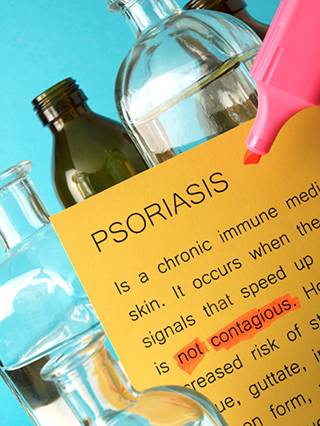
An experimental Johnson & Johnson drug for moderate to severe psoriasis proved significantly better at clearing the scaly, uncomfortable skin patches associated with the disease than a placebo, according to data from a midstage study presented on Saturday.
The J&J biologic medicine, guselkumab, achieved the main goal of the Phase II study at all five dosing regimens tested by clearing or reducing the psoriasis to a minimal measure after 16 weeks of treatment in a far greater percentage of patients than in the group that received a placebo. It also appeared to be as good as or more effective than AbbVie’s big selling Humira at four of the tested doses.
“The efficacy of guselkumab in the treatment of moderate to severe plaque psoriasis looks promising according to these Phase IIb study results,” Dr. Kristina Callis Duffin, one of the study’s investigators, said in a statement.
Results were determined using Physician Global Assessment (PGA) scores – a zero to 5 scale in which 0 indicates the disease has been cleared, 1 represents minimal disease and 5 indicates the most severe symptoms.
Guselkumab led to scores of 0 or 1 in as high as 86 percent of patients who received 100 milligrams of the drug every eight weeks, and in 83 percent of patients who were injected with 200 mg of the J&J medicine at the start of the trial and at week 4 and then every 12 weeks.
At the lower end, 34 percent of patients who got 5 mg of the drug to start and at week 4 and then every 12 weeks achieved PGA scores of 0 or 1. That was still deemed to be statistically significant compared with 7 percent for those who got a placebo.
In the Humira (adalimumab) group, 58 percent had scores of 0 or 1 after 16 weeks of treatment.
Results of the 293-patient trial, dubbed X-Plore, were presented at the American Academy of Dermatology (AAD) meeting in Denver. J&J has not yet said which of the treatment regimens would be advanced to larger, pivotal Phase III trials.
Guselkumab, which would be a follow-up treatment to J&J’s Stelara, works by blocking interleukin-23, or IL-23, a protein that has been associated with chronic inflammation and is believed to play a role in psoriasis.
Morningstar analyst Damien Conover said the drug “is really under the radar right now.” He currently sees sales reaching about $500 million several years after approval, but said estimates could change if later Phase III data were impressive.
In addition to the primary goal, significantly higher proportions of guselkumab patients achieved at least a 75 percent improvement in psoriasis as measured by the Psoriasis Area Severity Index (PASI 75) at week 16. Those results ranged from 44 percent of patients taking the lowest dose up to 81 percent at higher dosing regimens. That compared with 5 percent for placebo and 70 percent for Humira.
A 90 percent improvement was seen in as high as 62 percent of patients who got 100 mg of guselkumab every eight weeks.
The results remained consistent or showed additional improvement after 40 weeks of treatment, the company said.
After a year of treatment, serious adverse side effects were reported in 3 percent of those treated with guselkumab and 5 percent for Humira.
There were no cases of tuberculosis or opportunistic infections. One guselkumab patient reported a malignancy and there were three major adverse heart events, including one fatal heart attack, in patients with pre-existing cardiovascular risk factors, the company said.
Psoriasis, an immune-system related disease that causes an overproduction of skin cells resulting in patches of thick inflamed skin covered with silvery scales, affects 125 million people worldwide and about 7.5 million Americans, according to the National Psoriasis Foundation.
Source: healcon

